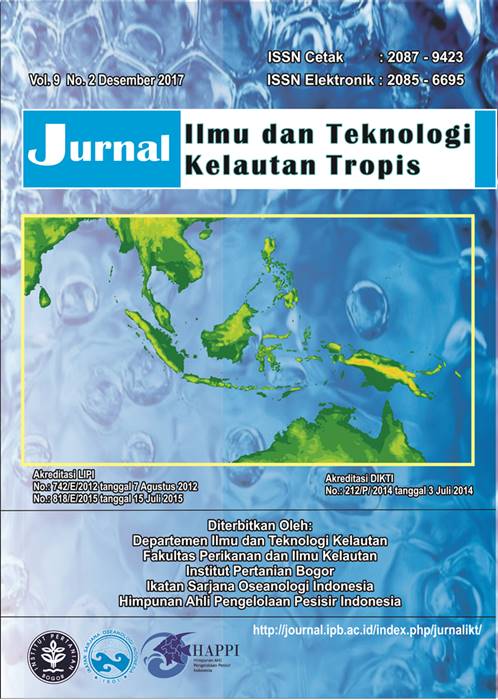ESTIMASI STOK KARBON MANGROVE (ABOVEGROUND) DI TANJUNG API-API, SUMATERA SELATAN
Abstract
The rapid development of infrastructure that occurred in the area of Tanjung Api-api resulted in changes in the function of mangrove land along the coast. Directly, this also impacts on the sustainability of ecological functions of mangroves. This study aims to estimate changes (prior to infrastructure development and current conditions) of aboveground carbon reserves stored in mangrove forests in Tanjung Api-api. This research was conducted in June-August 2016. Carbon stocks in mangrove along Tanjung Api-api were conducted by surveying the mangrove species and density, and then calculating biomass and carbon stock using allometric equation. While changes in carbon stocks are calculated by converting changes in mangrove area before and after infrastructure development to carbon stock value. The change of mangrove area was done by doing image data processing in 2005 and 2016. The results showed that mangrove Tanjung Api-api has 9 species of mangrove with total mangrove aboveground biomass of Tanjung Api-api is 1.1498 Mg.ha-1 and stored carbon of 0.5235 MgC.ha-1 and able to absorb CO2 of 1.1921 MgC.ha-1. The result of satellite image processing shows that there is a reduction of mangrove land of 1056.6 ha during the last 11 years from 9741.15 ha in 2005 (before development) to 8684.55 ha in 2016. Thus, there is a decrease of mangrove biomass by 1214.894 Mg, carbon stock is reduced by 553.090 MgC and CO2 uptake is reduced by 2029.84 MgC.
Keywords : aboveground, CO2, mangrove, Tanjung Api-api
Authors
This work is licensed under a Creative Commons Attribution 4.0 International License.
Jurnal Ilmu dan Teknologi Kelautan Tropis i is an open-access journal, meaning that all content is freely available without charge to the user or their institution. Users are allowed to read, download, copy, distribute, print, search, or link to the full texts of the articles in this journal without needing to request prior permission from the publisher or the author.
All articles published by Jurnal Ilmu dan Teknologi Kelautan Tropis are licensed under the Creative Commons Attribution 4.0 International License. This allows for unrestricted use, distribution, and reproduction in any medium, provided proper credit is given to the original authors.
Authors submitting manuscripts should understand and agree that the copyright of published manuscripts is retained by the authors. Copyright encompasses the exclusive rights of authors to reproduce, distribute, and sell any part of the journal articles in all forms and media. Reproduction of any part of this journal, its storage in databases, and its transmission by any form or media is allowed without written permission from Jurnal Ilmu dan Teknologi Kelautan Tropis.


